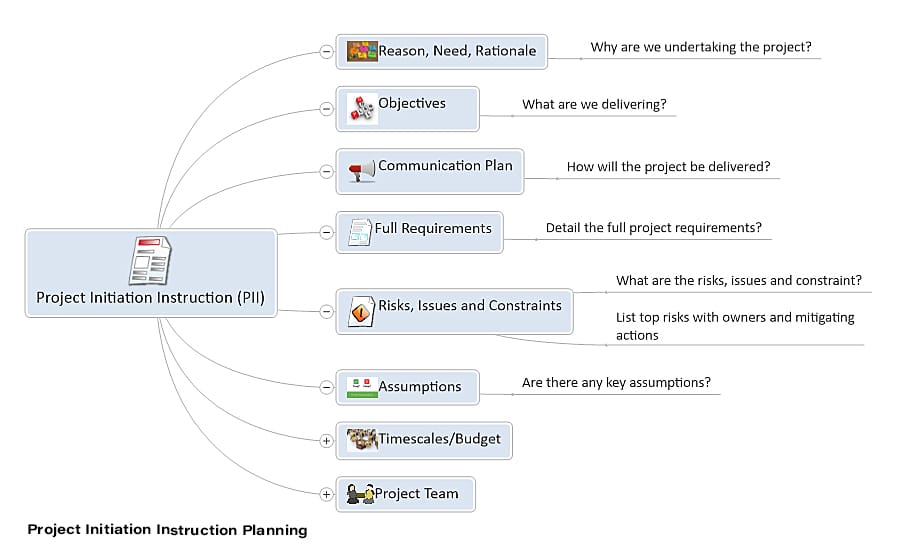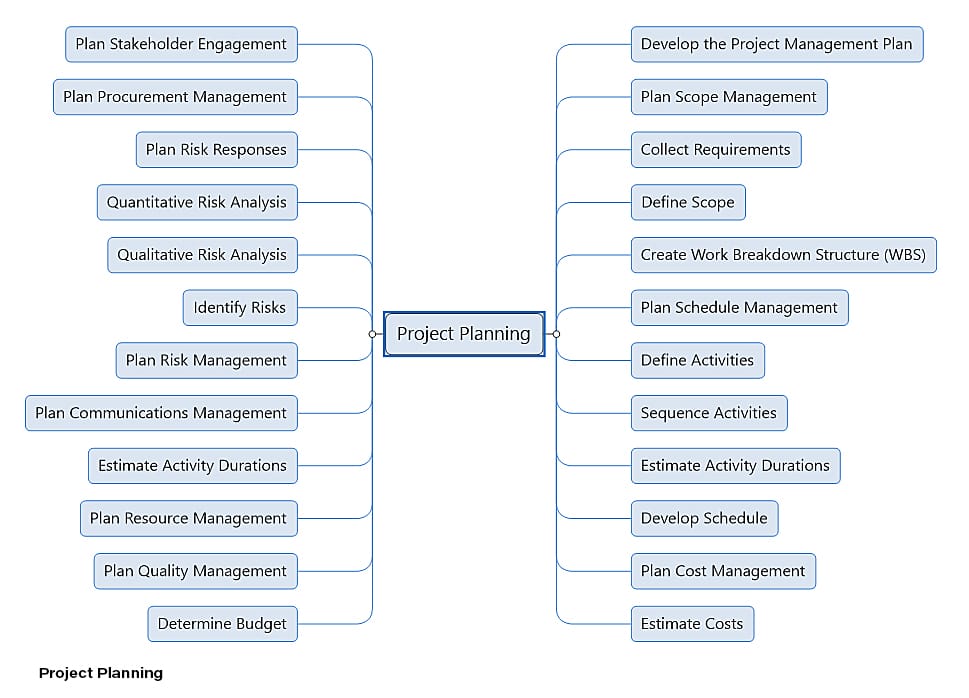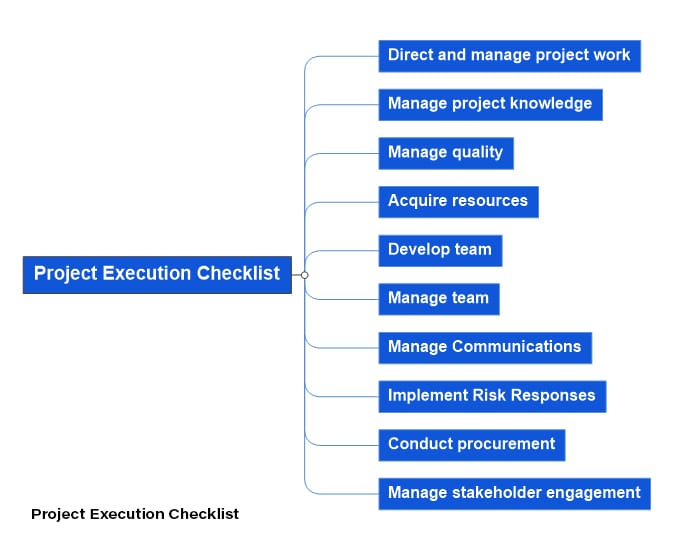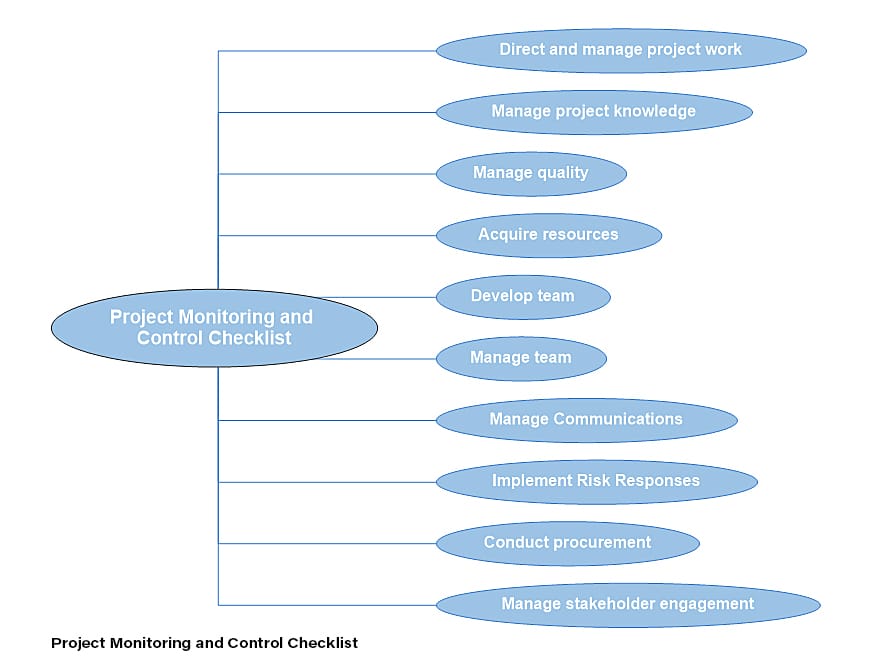Project Management Process Groups
Being given a project can seem daunting at first – a huge amount of work, individual tasks which need to be planned, managed and completed on time. Some tasks might depend on others being completed first before they can even begin.
The easiest approach is to break things down into phases. This is what the project management processes do. It’s a structured approach to getting the project from start to finish on time, on budget and to the standard expected so the finished result meets the original requirements.
The PMI Project Management Body of Knowledge splits these processes into 5 phases:
Project Initiation – Project Planning – Project Execution – Project Monitoring and Control Project Close
1. Project Initiation
Initiation is the first phase of the project lifecycle and is about gaining approval for the project to proceed, this can be done by deciding on project value and feasibility. The example below shows the topics that need to be considered and is a helpful guide for a Project Initiation Brainstorming session.

Two documents can be produced at this stage to help in the decision making:
- The Business Case Document which outlines the justification for the project and includes an overview of the overall financial benefits and
- The Feasibility Study which examines the project’s goals, timeline and costs to decide if go ahead should be given.
During initiation, stakeholders will be identified and the project manager will be appointed if they weren’t already in place. The outcome of this phase is the Project Charter, this is the document which gives authorisation for the project to go ahead and for resources to be assigned to the project.
The output at this stage is:
- Develop the Project Charter
- Identify Stakeholders
Back to Process Groups Menu
2. Project Planning
Once a project has been given the go ahead and the Project Charter produced, the planning can begin. Project success depends on a solid planning process which serves as a guide for the entire project team throughout the project and if done accurately, should keep the project on time and on budget.
The planning process will produce the project management plan and the project documents. The initial project management plan produced and agreed during planning will form the Baseline of the project.
The project management plan will detail how resources will be obtained, financial requirements and processes for the procurement of materials. The project team will refer to the plan for direction on the output of each stage of the project, risk mitigation, acceptance criteria, communication plans and how suppliers will be managed.
The output at this stage is:

Download this Project Planning mind map in MindGenius
Back to Process Groups Menu
3. Project Execution
Project execution is the completion of the work outlined in the plan that is required to meet the project deliverables. This is why the planning is so important – get the planning wrong and execution will fail.
Project managers lead their team members in the execution of the project by allocating resources and keeping team members focused on delivery.
During this phase, the project budget, resources and time allocations begin to be used up. As work progresses, change requests may be raised which will alter plans, documents and could result in a revised baseline.
The output at this stage is shown below in a handy checklist:

Download this Project Execution mind map in MindGenius
Back to Process Groups Menu
4. Project Monitoring and Control
The monitoring and control phase of project management is where progress is tracked and reviewed and is where any changes required to the original plan will be identified.
Monitoring is the analysis of performance data, producing performance measures and reporting on the results. Controlling is the comparison of actual performance and planned performance and implementing corrective action when necessary. The process involves:
- Evaluating change requests and deciding on the appropriate response
- Anticipating potential problems to recommend corrective or preventive action
- Monitoring project activities against the project management plan and baseline
- Managing the change control processes, ensuring only approved changes are implemented
The monitoring and control phase of a project is often done in conjunction with the execution phase as the project performance will be monitored throughout delivery.
It is through the process of monitoring and control that the team can ensure that project deliverables meet expectations of what was originally agreed to. It is this level of constant vigilance and attention to detail which keeps a project running smoothly and on track.
The output at this stage is outlined below in a checklist:

Download this Project Monitoring and Control Checklist in MindGenius
Back to Process Groups Menu
5. Project Close
The project close phase does exactly what it says – it’s the formal closure of a project and handover of the deliverables. Remember that by it’s nature, a project is a temporary piece of work so it will come to an end.
In addition to handover of deliverables, project closure includes communicating completion to stakeholders and releasing project resources to make them available for other projects.
A key component of closing a project is to hold a lessons learned session to learn from what went well and what went wrong so these processes can be applied to future projects and helps project teams to become more successful.
This stage would also address the early closure of a project where it has been cancelled.
This final stage only includes one output and that is simply:
- Close project or phase
Back to Process Groups Menu
Summary
These 5 project phases combine with the ten project management knowledge areas to help anyone manage successful projects of any size.
Download any of the examples on this page to open in MindGenius.
Don’t have MindGenius installed? No problem – simply start your FREE 14 day trial to see how these templates can help you manage any project.
